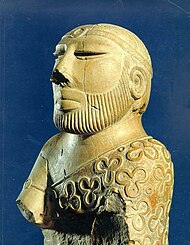One Unit Scheme

| History ofBangladesh |
|---|
 |
|
|
| History ofPakistan |
|---|
 |
| Timeline |
TheOne Unit Scheme(Urdu:ون یونٹ;Bengali:এক ইউনিট ব্যবস্থা) was the reorganisation of the provinces of Pakistan by the centralPakistani government.It was led byPrime MinisterMuhammad Ali Bograon 22 November 1954 and passed on 30 September 1955. The government claimed that the programme would overcome the difficulty of administering the two unequal polities ofWestandEastPakistan separated from each other by more than a thousand miles.[1]To diminish the differences between the two regions, the 'One Unit' programme merged the four provinces ofWest Pakistan(West Punjab,Sind,NWFP&Baluchistan) into a single province to parallel the province ofEast Pakistan(now Bangladesh).
The One Unit program was met with great resistance and grievances were raised by the four provinces since its establishment. As per scholar Julien Levesque, the One Unit project had mainly been pushed by thePunjabielite of West Pakistan since 1953 with the aim of preventing politicians from East Pakistan from gaining power at the centre.[2]TheNational Awami Partysuccessfully sponsored a bill in the National Assembly calling for its dissolution and providing for regional autonomy. This led to the military takeover of the national government.[3]The One Unit programme remained in effect until 1970.[1]Finally,PresidentGeneralYahya KhanimposedLegal Framework Order No. 1970to end the One Unit program and reinstate the provisional status of the Four Provinces as ofAugust 1947.[1]
Background[edit]
Following the failure to implement the Bogra Formula, PM Muhammad Ali Bogra began working towards the controversial One Unit program that integrated the Four Provinces into a single province West Pakistan, to equalize the western wing with the eastern wing, East Pakistan.
During this time, Ghulam Muhammad's health began to deteriorate, and paralysis spread through his whole body, forcing him to take a 2 month leave of absence in 1955 to seek treatment in the United Kingdom. Iskander Mirza was appointed as acting governor-general on 7 August 1955. Soon after the appointment, Acting Governor-General Mirza began having confrontations with Prime Minister Bogra on regional disparity though both were Bengali and were from Bengal, and Mirza forced Prime Minister Bogra to resign, appointing him as the Pakistan Ambassador to the United States. On 12 August 1955, he invited Muhammad Ali, the Finance Minister, to take over the government as a prime minister. The One Unit policy was passed on 30 September 1955 by the new Prime Minister Chaudhry Muhammad Ali. Mirza dismissed Malik Ghulam to take over his post on 6 October 1955 (just one day before his acting capacity ended), supported by the Constituent Assembly's legislators (as Ghulam Muhammad was seen as despotic).
History[edit]
Pakistan wasconceivedby philosopherSir Muhammad Iqbalin 1930 (uniting the four states of the northwesternBritish Indian Empire), the country wasestablishedon 14 August 1947, directly resulting from thePakistan Movementled byMuhammad Ali Jinnah.Since then, the country had been without a consolidated written constitution, and all Pakistan's state affairs had been run under constitutional acts of theBritish Indian Empire,such as theGovernment of India Act 1935and theIndian Independence Act 1947.
TheGovernmenthad prolonged difficulty in administeringEast Bengal,with its border withEastern India,and the four provinces, which borderWestern India,Iran, China, and Afghanistan.
One Unit was conceived by then-Governor-General Malik Ghulam and drafting was completed by then-chief MinisterMumtaz Daultana.The first official announcement about it was made on 22 November 1954. Rationalizing the framework, Bogra enumerated the benefits of having one unit or province: "There will be no Bengalis, no Punjabis, no Sindhis, no Pathans, no Balochis, no Bahawalpuris (Punjabis of Abbasi Bahawalpur Kingdom), no Khairpuris (Sindhis of Khairpur Mirs Talpur Kingdom). The disappearance of these groups will strengthen the integrity of Pakistan."[4]Prime MinisterChaudhry Muhammad Aliimplemented the framework of the One Unit program on 14 October 1955 after Pakistan National Assembly passed a bill merging all of West Pakistan into a single province on 30 September 1955.
1. It would end the curse of provincial prejudices.
2. It would allow the development of backward areas.
3. It would reduce administrative expenses.
4. It would make it easier to draw up a new constitution.
5. It would give East and West Pakistan maximum autonomy.
(The reasons given to the Assembly for adopting the One Unit Scheme byIskander Mirzain September 1955.)[5]
After the1954 general election,the four provinces andTribal Areaswere merged in the western wing. The province was composed of twelvedivisionsand the provincial capital was established atLahore.The province ofEast Bengal(includingSylhetand the Hill Tracts) was renamedEast Pakistanwith the provincial capital atDacca.The federal government moved the country's capital in the beginning of the year 1959 fromKarachitoRawalpindi(serving as provisional capital until the town planning ofIslamabadwas carried out and completed).
West Pakistanformed a single and united political entity but with marked linguistic and ethnic distinctions. The One Unit policy was regarded as an administrative reform that would reduce expenditure and help eliminate ethnic and parochial prejudices. However, with the military coup of 1958, trouble loomed for the province when the office ofChief Ministerwas abolished and the President claimed executive power overWest Pakistan.The province ofWest Pakistanwas dissolved on 1 July 1970 by President GeneralYahya Khan.
References[edit]
- ^abc"One Unit".Story of Pakistan.Retrieved16 May2013.
- ^Schaflechner, Jürgen; Oesterheld, Christina; Asif, Ayesha, eds. (2020).Pakistan: alternative imag(in)ings of the nation state(First ed.). Karachi: Oxford University Press. p. 247.ISBN0190701315.
The One Unit project had mainly been pushed by the Punjabi elite of West Pakistan since 1953 with the aim of preventing politicians from East Pakistan from gaining power at the centre.
- ^Talbot 1998,p. 86.
- ^The History And Culture of Pakistan, by Nigel Kelly. Retrieved 16 August 2015
- ^The History And Culture of Pakistan, Nigel Kelly. Retrieved 16 August 2015
Bibliography[edit]
- Talbot, Ian (1998),Pakistan: A Modern History,St. Martin's Press,ISBN978-0-312-21606-1
External links[edit]
- Formation of One Unit,storyofpakistan website, West Pakistan Established as 'One Unit' province on 30 Sept.1955. Retrieved 16 August 2015
